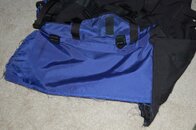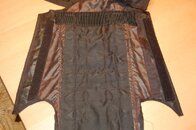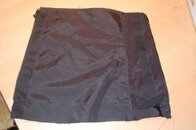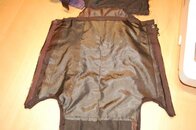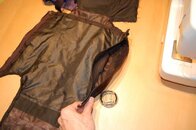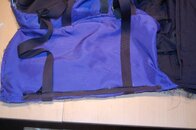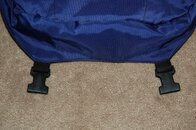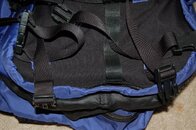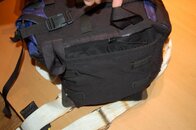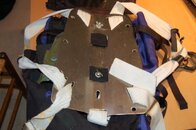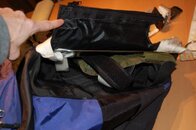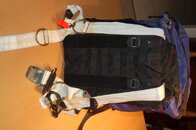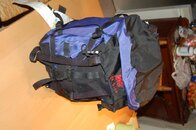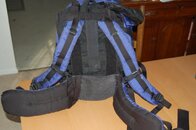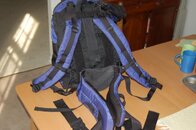And now for the next couple of steps in the process:
11) Side panel options: Side panels provide several different options for pockets, access zippers, and gear loops/straps. I chose to do one side panel with two "stacked" pockets, a short one layered on a taller one, and one side panel with two gear cinch straps. Option 11a will discuss pockets. Option 11B will discuss gear straps.
11a) Pockets provide several options in and of themselves. I have open-ended "drink bottle" pockets that lay flat against the sides of my bag. I layered mine. Other options are closed pockets, "loose" drink pockets and of course different size pockets as well as the option of "hidden pockets" that are nestled invisibly inside other obvious pockets.
i) Hidden pockets:
To do this just cut two pocket panels of the same size. Fold and sew the top edge ofeach panel (wrong side together) at 3/8 inch. Sew 1" velcro to the wrong side top edge of each panel. Sew the remaining three edges together at 3/8 inch. Sew the remaining pocket as you would a "standard pocket and you now have two pockets in one. These are great for small items like keys, credit cards, and similar items.
ii) Closable pockets:
Like hidden pockets, these can be made as fully independent pockets that are then sewn in to the bag or they can be sewn integrated with one side of the pocket being the side of the bag. If integrated into the bag, just replace the closure (velcro or zippers as you prefer) on the second pocket panel by putting them directly on the bag side panel where you want the pocket.
iii) Once you've got your pockets ready, pin them wrong side facing the right side of the side panel. Sew 3/8 inch at side panel edges, as appropriate. (IE a drink pocket at the bottom of the bag could be sewn at bottom and both side edges. A pocket at the center of the bag might be sewn at only the front and back edges of the side panels, or all four edges as appropriate.)
11b) Gear straps, as with pockets, provide several options. Clipping straps, cinch straps, daisy chain style straps, and many other options. For my example bag, I chose cinch straps. Whatever your choice, they're all basically sewn in the same way.
Get the straps sewn in at the front and back edges of the side panel at the desired location. Be sure not to interfere with any pockets when deciding placement. For cinch straps, put the cinch d-ring on a short section of webbing and sew onto the right side of pocket panel edge with the d-ring toward the center of the pocket panel. Sew the "loose" end of the cinch strap to the opposite (front or back) edge of the side panel in line with the d-ring. For clipping straps, sew the webbing onto the right side of the side panel at front and back edges in the desired location. If the clip buckle only allows for one
sliding buckle part and one fixed part, treat the fixed buckle part just like the d- ring in the cinch strap.
Use 3/8 inch seam allowance for all straps and sew using double or triple bar stitches.
12) Once gear straps/pockets are fixed on the side panels, pin side panels, rounded edge (at top) to front panel of the bag, right sides together. Front edge of pocket should align with "free" edge of the zipper and zipper cover panel sewn in step 3 above.
13) Fold the bottom panel side edge up to meet side panel bottom edge, right sides together and pin. Sew at 3/8 inch.
(you should now have a 3-sided bag with a bottom and no back)
The following pictures were taken after competing step 13. In both pictures, the back panel edge of the side panel (unsewn) is at the bottom of the image.
Step 11 with layered pockets:
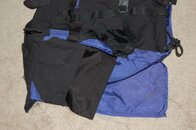
Step 11 with fixed d-rings of cinch straps:
